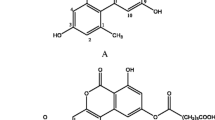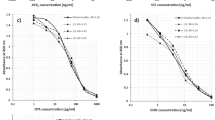Abstract
Sterigmatocystin (STG) is a highly toxic secondary fungal metabolite structurally closely related to the well-known carcinogenic aflatoxins. Its presence has been reported in grains and grain-based products as well as in other foodstuffs like nuts, green coffee beans, spices, beer and cheese. Due to the lack of suitable data on the occurrence of STG, in 2013, the European Food Safety Authority (EFSA) could not characterise its risk for human health and recommended that more data on STG in food and feed needed to be collected. In order to provide a new tool for the specific detection of STG, a competitive enzyme-linked immunosorbent assay (ELISA) was developed, optimised and validated in this study based on a sensitive monoclonal antibody specific to STG with no cross-reactivity with aflatoxins. The sample preparation method for rice, wheat and maize was based on a modified QuEChERS (quick, easy, cheap, effective, rugged and safe) approach. The assay was validated for the detection of STG in rice, wheat and maize in accordance with the guidelines for validation of semi-quantitative screening methods included in Commission Regulation (EU) 519/2014. The screening target concentration (STC) was set at 1.5 μg/kg. The cutoffs for rice, wheat and maize were 1.2, 1.2 and 1.3 μg/kg and the false suspected rates were 0.34, 1.15 and 0.78%, respectively. Good correlation was found between the results obtained by the STG ELISA and LC-MS/MS method for naturally contaminated rice samples. This validated method can be applied as a sensitive and high-throughput screening for the presence of STG in a range of agricultural commodities.

A new enzyme-linked immunosorbent assay based on an antibody specific to sterigmatocystin for the detection of this mycotoxin in corn, wheat and rice.




Similar content being viewed by others
References
Bhat R, Rai RV, Karim AA. Mycotoxins in food and feed: present status and future concerns. Compr Rev Food Sci F. 2010;9:57–81.
European Commission. Commission regulation (EC) no 1881/2006 of 19 December 2006 setting maximum levels for certain contaminants in foodstuffs. Off J Eur Union. 2006;L364:5–23.
European Commission. Commission recommendation of 17 August 2006 on the presence of deoxynivalenol, zearalenone, ochratoxin A, T-2 and HT-2 and fumonisins in products intended for animal feeding (2006/576/EC). Off J Eur Union. 2006;L229:7–9.
European Commission. Commission Recommendation of 27 March 2013 on the presence of T-2 and HT-2 toxin in cereals and cereal products (2013/165/EU). Off J Eur Union. 2013;L91:12–5.
International Agency for Research on Cancer (IARC). Chemical agents and related occupations. A review of human carciongens. In: IARC Monographs on the Evaluation of Carcinogenic Risks to Humans. 2012;100F:225–244.
European Food Safety Authority (EFSA). Scientific opinion on the risk for public and animal health related to the presence of sterigmatocystin in food and feed. EFSA J. 2013;11(6):3254.
Veršilovskis A, De Saeger S. Sterigmatocysin: occurrence in foodstuffs and analytical methods—an overview. Mol Nutr Food Res. 2010;54:136–47.
International Agency for Research on Cancer (IARC). Some naturally occurring substances. In: IARC Monographs on the Evaluation of Carcinogenic Risks to Humans. Summaries and Evaluations. 1987;10:72.
Stroka J, Dasko L, Spangenberg B, Anklam E. Determination of the mycotoxin, sterigmatocystin, by thin-layer chromatography and reagent-free derivatisation. J Liq Chromatogr Relat Techno. 2004;27:2101–11.
Mol HGJ, Pietri A, MacDonald SJ, Anagnostopoulos C, Spanjer M. Survey on sterigmatocystin in food. EFSA Supporting Publication. 2015;EN-774:56.
Veršilovskis A, Bartkevičs V, Miķelsone V. Sterigmatocystin presence in typical Latvian grains. Food Chem. 2008;109:243–8.
Marley E, Brown P, Mackie J, Donnelly C, Wilcox J, Pietri A, et al. Analysis of sterigmatocystin in cereals, animal feed, seeds, beer and cheese by immunoaffinity column clean-up and HPLC and LC-MS/MS quantification. Food Addit Contam A. 2015;32:2131–7.
Zhao Y, Huang J, Ma L, Wang F. Development and validation of a simple and fast method for simultaneous determination of aflatoxin B1 and sterigmatocystin in grains. Food Chem. 2017;221:11–7.
Ok HE, Tian F, Hong EY, Paek O, Kim S-H, Kim D, et al. Harmonized collaborative validation of aflatoxins and sterigmatocystin in white rice and sorghum by liquid chromatography coupled to tandem mass spectrometry. Toxins. 2016;8:371.
Biancardi A, Dall’Asta C. Determination of sterigmatocystin in feed by LC-MS/MS. Food Addit Contam. 2015;32:2093–100.
Sulyok M, Krska R, Schuhmacher RA. A liquid chromatography/tandem mass spectrometric multi-mycotoxin method for the quantification of 87 analytes and its application to semi-quantitative screening of moldy food samples. Anal Bioanal Chem. 2007;389:1505–23.
Monbaliu S, Van Poucke C, Detavernier C, Dumoultn F, Van Velde MDE, Schoeters E, et al. Occurrence of mycotoxins in feed as analysed by a multi-mycotoxin LC-MS/MS method. J Agr Food Chem. 2010;58:66–71.
Jackson LC, Kudupoje MB, Yiannikouris A. Simultaneous multiple mycotoxin quantification in feed samples using three isotopically labeled internal standards applied for isotopic dilution and data normalization through ultra-performance liquid chromatography/electrospray ionization tandem mass spectrometry. Rapid Commun Mass Sp. 2012;26:2697–713.
Malachová A, Sulyok M, Beltrán E, Berthiller F, Krska R. Optimization and validation of a quantitative liquid chromatography-tandem mass spectrometric method covering 295 bacterial and fungal metabolites including all regulated mycotoxins in four model food matrices. J Chromatogr A. 2014;1362:145–56.
Oplatowska-Stachowiak M, Haughey SA, Chevallier OP, Galvin-King P, Campbell K, Magowan E, et al. Determination of the mycotoxin content in distiller’s dried grain with solubles using a multianalyte UHPLC–MS/MS method. J Agr Food Chem. 2015;63:9441–51.
Kong D, Xie Z, Liu L, Song S, Kuang H, Cui G, et al. Development of indirect competitive ELISA and lateral-flow immunochromatographic assay strip for the detection of sterigmatocystin in cereal products. Food Agr Immunol. 2017;28:260–73.
Li M, Li P, Wu H, Zhang Q, Ma F, Zhang Z, et al. An ultra-sensitive monoclonal antibody-based competitive enzyme immunoassay for sterigmatocystin in cereal and oil products. PLoS One. 2014;9:e106415.
Li S, Chen PY, Marquardt RR, Han Z, Clarke JR. Production of a sensitive monoclonal antibody to sterigmatocystin and its application to ELISA of wheat. J Agr Food Chem. 1996;44:372–5.
European Commission. Commission regulation (EU) 519/2014 of 16 May 2014 amending regulation (EC) no 401/2006 as regards methods of sampling of large lots, spices and food supplements, performance criteria for T-2, HT-2 toxin and citrinin and screening methods of analysis. Off J Eur Union. 2014;L147:29–43.
Kononenko GP, Burkin AA, Soboleva NA. Comparative characterization of immune reagents based on hemiacetals of aflatoxin B1 and sterigmatocystine. Appl Biochem Micro. 2002;38:487–92.
Oplatowska-Stachowiak M, Sajic N, Xu Y, Haughey SA, Mooney MH, Gong YY, et al. Fast and sensitive aflatoxin B1 and total aflatoxins ELISAs for analysis of peanuts, maize and feed ingredients. Food Control. 2016;63:239–45.
Köhler G, Milstein C. Continuous cultures of fused cells secreting antibody of predefined specificity. Nature. 1975;256:495–7.
Oplatowska-Stachowiak M, Kleintjens T, Sajic N, Haasnoot W, Campbell K, Elliott CT, et al. T-2 toxin/HT-2 toxin and ochratoxin A ELISAs development and in-house validation in food in accordance with commission regulation (EU) no 519/2014. Toxins. 2017;9:388.
Acknowledgements
The authors would like to thank Lucia Streppel and Piet van Wichen from EuroProxima for their support of this research.
Funding
This project has received funding from the European Union’s Horizon 2020 research and innovation programme under the Marie Sklodowska-Curie grant agreement No 655119.
Author information
Authors and Affiliations
Corresponding author
Ethics declarations
Conflict of interest
The authors declare that they have no conflict of interest.
Research involving animals
Animal experiments were performed in accordance with the UK Animals Scientific Procedures Act 1986 under the license PPL2756 issued on the 12/02/2014 by the Department of Health, Social Services and Public Safety for Northern Ireland. The study received approval from the Queens University Belfast Animal Welfare and Ethical Review Body on 09/01/2014.
Rights and permissions
About this article
Cite this article
Oplatowska-Stachowiak, M., Reiring, C., Sajic, N. et al. Development and in-house validation of a rapid and simple to use ELISA for the detection and measurement of the mycotoxin sterigmatocystin. Anal Bioanal Chem 410, 3017–3023 (2018). https://doi.org/10.1007/s00216-018-0988-8
Received:
Revised:
Accepted:
Published:
Issue Date:
DOI: https://doi.org/10.1007/s00216-018-0988-8




